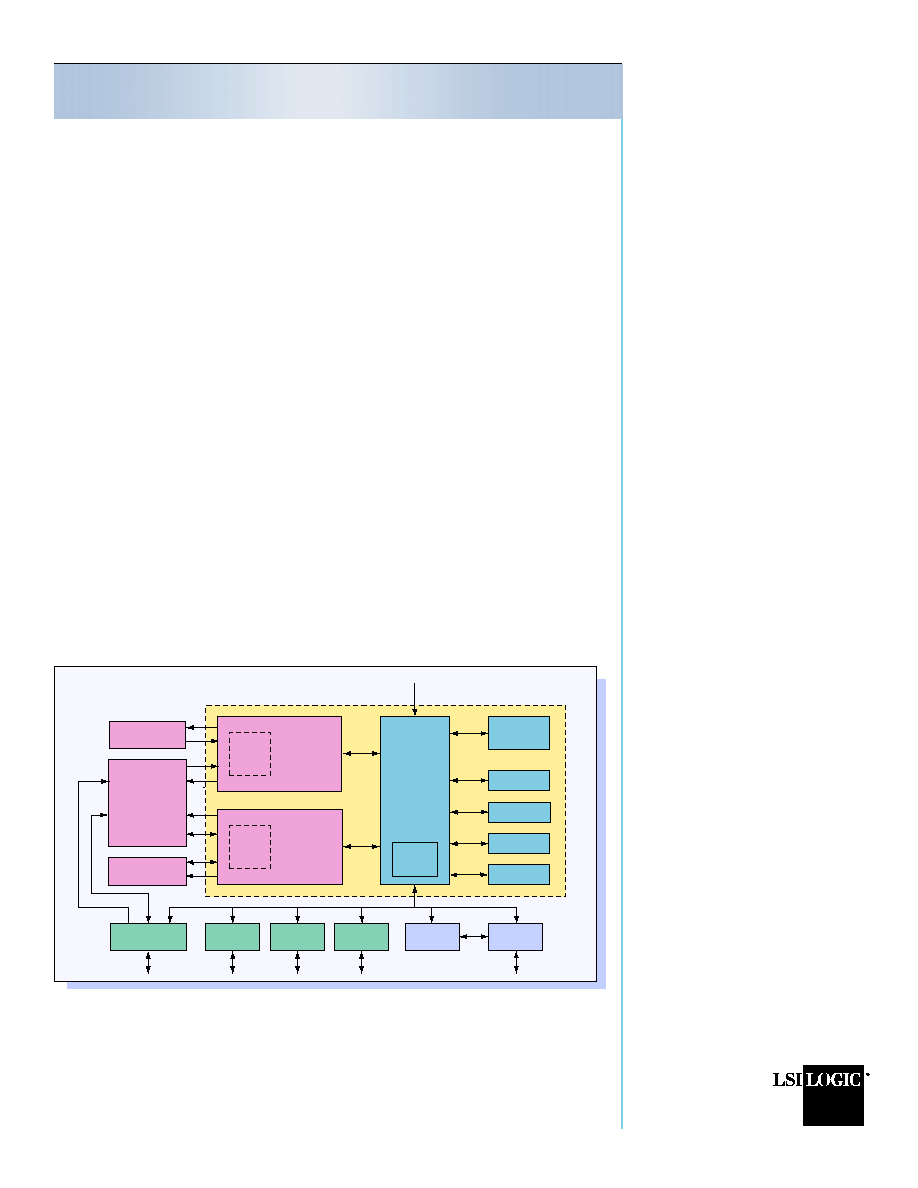
ZSP Architecture Performance with High-End Integration
Overview
The LSI402Z is a high-performance 16-bit fixed-point digital signal processor
(DSP) based on the ZSP
TM
Architecture. This device has been designed for
applications that require high data throughput capability coupled with high-speed
I/O, such as communications infrastructure equipment, and offers enhanced I/O
capabilities and large on-chip memory. The LSI402Z is capable of a maximum
clock rate of 200 MHz for 800 MIPS peak performance and sustained effective
throughput of 400 DSP MIPS (MACs).
Memory
The internal memory structure of the LSI402Z comprises 62K words of dual-access
RAM, 2K words of boot ROM and 2K words of data space dedicated to memory-
mapped registers and external peripherals. Dual-access RAM can be freely used as
both instruction and data memory. The boot ROM contains several routines,
including internal self-test, and boot-loader routines. The Memory Interface Unit
(MIU) provides a glueless interface to industry-standard 32-bit synchronous-burst
SRAMs (SBSRAMs), and 16-bit asynchronous SRAMs and ROM devices. The
total address range of the MIU is 20 bits, organized as sixteen 64K word pages
which are selected by a software-controlled page register.
LSI402Z Digital Signal Processor
Boot ROM
Dual-Access
RAM
Timer 0
Timer 1
I Cache
Instruction
Unit
Pipeline
Control
Unit
Interrupts
Register
File
ALU
ALU
MAC
MAC
D Cache
Data Unit
Memory-Mapped
Registers
MIU/DMA
HPI
TDM Serial
Port 1
TDM Serial
Port 0
DEU
JTAG
Functional Block Diagram
Features
∑
200 MHz operation at 1.8 V (5 ns cycle time)
∑
Two high-speed serial/TDM ports (T1/E1
framer, H.100/H.110 bit stream compatible)
∑
Low power dissipation (< 1 W at 200 MHz)
∑
62K words RAM, 2K words ROM on-chip
∑
Eight-channel DMA support
∑
On-board PLL for clock generation
∑
32-/16-bit external memory interface
∑
Two on-board timers
∑
16-bit host processor interface
∑
IEEE 1149.1-compliant JTAG port for real-
time emulation and system download
∑
208 mBGA package
Benefits
∑
400 MMAC sustained DSP performance
∑
Direct interfacing to standard
telecommmunication interfaces, reducing
system cost
∑
Very low power per channel
∑
Low or zero system memory cost
∑
High data throughput without processor
overhead
∑
Flexibility to optimize power consumption
∑
High data bandwidth to off-chip devices
∑
RTOS support and increased system
integration
∑
Simple interfacing to industry-standard
micros
∑
Low overhead on chip debug
∑
Very high processing density per unit
area

LSI Logic logo design is a registered trademark and ZSP is a
trademark of LSI Logic Corporation. All other brand and
product names may be trademarks of their respective
companies.
LSI Logic Corporation reserves the right to make changes to
any products and services herein at any time without notice.
LSI Logic does not assume any responsibility or liability arising
out of the application or use of any product or service
described herein, except as expressly agreed to in writing by
LSI Logic; nor does the purchase, lease, or use of a product or
service from LSI Logic convey a license under any patent
rights, copyrights, trademark rights, or any other of the
intellectual property rights of LSI Logic or of third parties.
Copyright ©1999 by LSI Logic Corporation.
All rights reserved.
For more information please call:
Europe +32.11.300.351
www.lsilogic.com
LSI Logic Corporation
North American Headquarters
Milpitas, CA
Tel: 800.574.4286
LSI Logic Europe Ltd
European Headquarters
Bracknell, United Kingdom
Tel: 44.1344.426544
Fax: 44.1344.481039
LSI Logic KK Headquarters
Tokyo, Japan
Tel: 81.3.5463.7821
Fax: 81.3.5463.7820
Order No. R20012
999.1K.CM.TP ≠ Printed in USA
ISO 9000 Certified
LSI402Z Digital Signal Processor
DMA
The DMA controller of the LSI402Z can support up to eight individual channels
simultaneously, where all channels can access the entire 62K word dual-access
RAM. Either instructions or data can be transferred to or from the internal memory
space from the MIU, HPI, or either serial port. The eight DMA channels are
segmented into four "indexed" and four "non-indexed" channels. Indexed channels
have the ability to buffer data from either of the serial TDM interfaces. Non-
indexed channels perform sequential accesses to or from internal memory.
Timers
The LSI402Z has two identical 16-bit on-board timers for real-time interrupt
generation. Each timer is fully programmable, and has a 6-bit pre-scaler and interrupt
capability. The timers can automatically reload with the initial count so that periodic
interrupts can be generated.
TDM Serial Ports
The LSI402Z provides two identical synchronous serial ports that support 8- or
16-bit active or passive transfers, which can be either burst or continuous, with a
maximum active mode transfer rate of 100 Mbps (with a 200 MHz processor
clock). In passive mode, the maximum transfer rate is 200 Mbps. Both serial ports
provide the programmable feature of a TDM (time division multiplex) mode that
is compatible with T1/E1 framers or the local serial bus of H.100/ H.110 interface
devices. The TDM mode can also be used to establish a serial multiprocessor
communication link with only three signals.
Host Processor Interface (HPI)
The Host Processor Interface, or HPI, is an asynchronous 16-bit parallel port that
is compatible with both Motorola and Intel style interfaces, and supports word
(16-bit) transfers. The maximum transfer rate for the HPI is half of the processor
clock frequency (100M words per second given a processor operating frequency of
200 MHz).
Development Tools
The ZSP Processor family is fully supported by a GNU-based compiler, linker and
assembler, available for Windows 95/98/NT and Solaris 2 platforms. The ZSP
Architecture enables the C compiler to produce code unrivaled in code density
and execution speed by any DSP in its class, offering fast time to market with
optimal performance and cost. An integrated debug environment is available for
PC platforms.
An LSI402Z development platform is available, offering the following features:
∑
FLASH EPROM
∑
RS232C and JTAG-based host communication and code download
∑
512K words SBSRAM expansion program/data memory
∑
64K words asynchronous program/data memory
∑
Analog I/O interfaces

